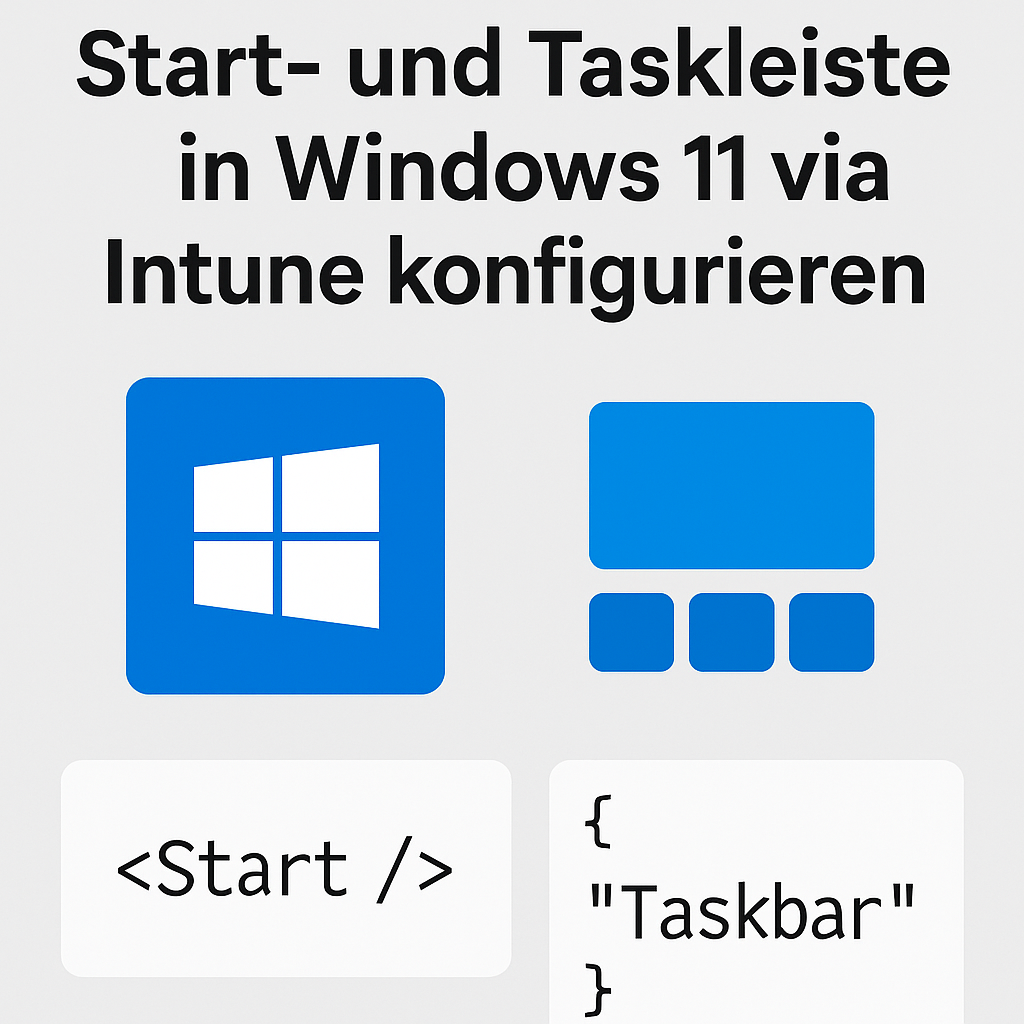Im Rahmen der Windows 11 Clientkonfiguration möchten wir ein einheitliches Nutzererlebnis sicherstellen – sowohl auf der Taskleiste (Taskbar) als auch im Startmenü (Start Menu). Ziel ist es, die wichtigsten Anwendungen für Benutzer standardisiert und gut sichtbar bereitzustellen.
Die Konfiguration erfolgt zentral über Microsoft Intune mittels zweier Gerätekonfigurationsprofile:
- Taskleiste (XML): Definiert, welche Programme in der Taskbar angeheftet werden. Die Konfiguration wird einmalig beim ersten Benutzer-Login angewendet.
- Startmenü (JSON): Legt die fixen Startmenü-Kacheln fest. Diese Konfiguration überschreibt das lokale Benutzerlayout vollständig und bleibt aktiv.
Die folgenden Abschnitte zeigen exemplarisch, wie die jeweiligen XML- und JSON-Inhalte aufgebaut sind und wie man sie in Intune als Settings catalog-Profile konfiguriert.
🔧 TASKBAR über XML (Start layout)
📄 Beispiel XML-Inhalt für Taskleiste
<?xml version="1.0" encoding="utf-8"?>
<LayoutModificationTemplate
xmlns="http://schemas.microsoft.com/Start/2014/LayoutModification"
xmlns:defaultlayout="http://schemas.microsoft.com/Start/2014/FullDefaultLayout"
xmlns:start="http://schemas.microsoft.com/Start/2014/StartLayout"
xmlns:taskbar="http://schemas.microsoft.com/Start/2014/TaskbarLayout"
Version="1">
<CustomTaskbarLayoutCollection PinListPlacement="Replace">
<defaultlayout:TaskbarLayout>
<taskbar:TaskbarPinList>
<taskbar:DesktopApp DesktopApplicationID="Microsoft.Windows.Explorer" />
<taskbar:UWA AppUserModelID="MSTeams_8wekyb3d8bbwe!MSTeams"/>
<taskbar:DesktopApp DesktopApplicationLinkPath="%ALLUSERSPROFILE%\Microsoft\Windows\Start Menu\Programs\Microsoft Edge.lnk" />
<taskbar:DesktopApp DesktopApplicationLinkPath="%ALLUSERSPROFILE%\Microsoft\Windows\Start Menu\Programs\Outlook (classic).lnk" />
<taskbar:DesktopApp DesktopApplicationLinkPath="%ALLUSERSPROFILE%\Microsoft\Windows\Start Menu\Programs\Excel.lnk" />
<taskbar:DesktopApp DesktopApplicationLinkPath="%ALLUSERSPROFILE%\Microsoft\Windows\Start Menu\Programs\PowerPoint.lnk" />
<taskbar:DesktopApp DesktopApplicationLinkPath="%ALLUSERSPROFILE%\Microsoft\Windows\Start Menu\Programs\Word.lnk" />
<taskbar:DesktopApp DesktopApplicationLinkPath="%ALLUSERSPROFILE%\Microsoft\Windows\Start Menu\Programs\SignOut.lnk" />
</taskbar:TaskbarPinList>
</defaultlayout:TaskbarLayout>
</CustomTaskbarLayoutCollection>
</LayoutModificationTemplate>
📍 Intune Umsetzung:
- Intune → Geräte > Konfigurationsprofile → Profil erstellen
- Plattform: Windows 10 and later, Profiltyp: Settings catalog
- Einstellungen:
- Suche nach „Start layout“
- Wähle:
Start > Start layout
- Inhalt: Füge oben stehendes XML in das Textfeld ein
- Zuweisung an Gerätegruppen
- Fertig
📌 STARTMENÜ über JSON (Configure Start Pins)
📄 Beispiel JSON-Inhalt für Start-Pins
"pinnedList": [
{ "desktopAppLink": "%APPDATA%\\Microsoft\\Windows\\Start Menu\\Programs\\SignOut.lnk" },
{ "desktopAppLink": "%ALLUSERSPROFILE%\\Microsoft\\Windows\\Start Menu\\Programs\\Microsoft Edge.lnk" },
{ "desktopAppLink": "%ALLUSERSPROFILE%\\Microsoft\\Windows\\Start Menu\\Programs\\Word.lnk" },
{ "desktopAppLink": "%ALLUSERSPROFILE%\\Microsoft\\Windows\\Start Menu\\Programs\\Excel.lnk" },
{ "desktopAppLink": "%ALLUSERSPROFILE%\\Microsoft\\Windows\\Start Menu\\Programs\\PowerPoint.lnk" },
{ "packagedAppId": "Microsoft.Windows.Photos_8wekyb3d8bbwe!App" },
{ "packagedAppId": "windows.immersivecontrolpanel_cw5n1h2txyewy!microsoft.windows.immersivecontrolpanel" },
{ "packagedAppId": "Microsoft.WindowsCalculator_8wekyb3d8bbwe!App" },
{ "packagedAppId": "Microsoft.WindowsAlarms_8wekyb3d8bbwe!App" },
{ "packagedAppId": "Microsoft.WindowsNotepad_8wekyb3d8bbwe!App" },
{ "packagedAppId": "Microsoft.Paint_8wekyb3d8bbwe!App" },
{ "desktopAppLink": "%APPDATA%\\Microsoft\\Windows\\Start Menu\\Programs\\File Explorer.lnk" },
{ "desktopAppLink": "C:\\ProgramData\\Microsoft\\Windows\\Start Menu\\Programs\\Greenshot\\Greenshot.lnk" },
{ "desktopAppLink": "C:\\ProgramData\\Microsoft\\Windows\\Start Menu\\Programs\\Outlook (classic).lnk" },
{ "desktopAppLink": "%ALLUSERSPROFILE%\\Microsoft\\Windows\\Start Menu\\Programs\\GIMP 2.10.38.lnk" },
{ "desktopAppLink": "%ALLUSERSPROFILE%\\Microsoft\\Windows\\Start Menu\\Programs\\PDF24\\PDF24.lnk" },
{ "packagedAppId": "BlenderFoundation.Blender_ppwjx1n5r4v9t!BLENDER" },
{ "desktopAppLink": "%ALLUSERSPROFILE%\\Microsoft\\Windows\\Start Menu\\Programs\\VideoLAN\\VLC media player.lnk" }
]
}
📍 Intune Umsetzung:
- Intune → Geräte > Konfigurationsprofile → Profil erstellen
- Plattform: Windows 10 and later, Profiltyp: Settings catalog
- Einstellungen:
- Suche nach „Configure Start Pins“
- Wähle:
Start > Configure Start Pins
- Inhalt: Füge oben stehenden JSON-Code ein
- Zuweisung an Gerätegruppen
- Fertig

